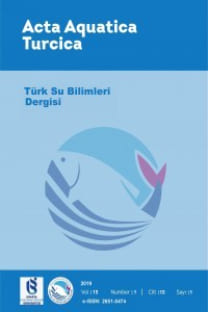Tatlısu Kereviti (Astacus leptodactylus Eschscholtz, 1823)’ un Embriyonik ve Postembriyonik Gelişimi
Tatlısu kerevitlerinden Astacus leptodactylus’un yumurta gelişimi hakkında çok az bilgi vardır. Özellikle A.leptodactylus’un post embryonik gelişimin bazı yapıları tanımlanmıştır. Fakat diğer türlerden farklı olarak uzun bir inkübasyon süresine (5-6 ay) sahip olan A. leptodactylus’ un embryonik gelişimleri tanımlanmamıştır. Bu çalışmada A. leptodactylus’ un yumurta gelişimi, yumurtlamadan III. dönem larva aşamasına kadar, doğal ortamlarındaki sıcaklık şartlarına benzer olarak oluşturulan laboratuar şartları altında 9oC ile 15oC’ ler arasında fotoğraflandırılarak çalışılmıştır. A. leptodactylus’ un yumurtaları belirtilen şartlar altında 1608 gün/derece de açılmıştır. Yumurta açılımından 7-8 gün sonra, I. dönem larvalar ilk kabuklarını değiştirerek II. döneme ulaşmışlardır. İlk kabuk değişiminden 9-10 gün sonra II. dönem larvalar ikinci kabuklarını değiştirerek III. döneme ulaşmışlardır.
Anahtar Kelimeler:
Embriyo, gelişim, Astacus leptodactylus, Astacidae, Kabuklular
Embryonic and Postembryonic Development of Freshwater Crayfish (Astacus leptodactylus Eschscholtz, 1823)
There is little knowledge about the egg development of freshwater crayfish (Astacus leptodactylus). Especially, some aspects of the postembryonic development of A. leptodactylus have been described in previous studies. However, all embryonic development of A. leptodactylus species, which has a long incubation period (5-6 month) has not been described. In this study, embryonic and post embryonic development of A. leptodactylus species was studied by a stereomicroscope under laboratory conditions which have similar temperature conditions with ones in their natural habitat in between 9oC -15οC. The eggs of this species hatched in 1608 degrees x days under these conditions. After 7-8 days of hatching, juvenile stage I reached to juvenile stage II with changing first moult. After 9-10 days of first moult, juvenile stage II reached to juvenile stage III with changing second moult.
Keywords:
Embryo, development, Astacus leptodactylus, Astacidae, crustacea,
___
- Baran, I., Soylu, E. 1989. Crayfish plague in Turkey. J Fish Dis., 12: 193−197.
- Celada, J.D., Gaudioso, V.R., Fernández, R. 1987. Embryonic development of the freshwater crayfish (Pacifastacus leniusculus Dana): a scanning electron microscopic study. Anat. Rec., 219:304–310.
- Celada, J.D.,, Carral, J.M., Gonzales, J. 1991. A study on the identification and chronology of the embryonic stages of the freshwater crayfish Austropotamobius pallipes (Lereboullet, 1858), Crustaceana, 61:225–232.
- Furst, M., Soderhall, K. 1987. The crayfish Astacus leptodactylus in Turkey: diseases and present distribution of the crayfish plague Aphanomyces astaci. FAO Report, Rome.
- Garcia-Guerrero, M., Hendrickx, M,E,, Villarreal, H. 2003. Description of the embryonic development of Cherax quadricarinatus (Von martens, 1868) (Decapoda, Parastacidae), based on the staging method. Crustaceana, 76 (3): 269-280.
- Gherardi, F., Acquistapace, P. 2007. Invasive crayfish in Europe: the impact of Procambarus clarkii on the littoral community of a Mediterranean lake. Freshw. Biol., 52:7, 1249-1259. Holdich, D.M. 1992. Crayfish nomenclature and terminology: recommendations for uniformity. Finnish Fisheries Research, 14: 149-155.
- Holdich, D.M., Reynolds, J.D., Souty-Grosset, C., Sibley, P.J. 2009. A review of the ever increasing threat to European crayfish from non-indigenous crayfish species. Knowledge and Management of Aquatic Ecosystems, 11:394-395.
- Koksal, G. 1984. Freshwater Crayfish Astacus leptodactylus salinus (Nordmann, 1842) Eggs and Embryonic and Post-embryonic Development Process Studies. Ege University Fisheries Faculty Journal, 1:3.
- Mason, J.C. 1978. Significance of egg size in the freshwater crayfish, Pacifastacus leniusculus Dana. Freshwater Crayfish. Pierre-J. Laurent, ed. Thonon les Bains, France, 5: 83-92.
- Pawlos, D., Korzelecka-Orkisz, A., Wesolowski, P., Formicki, K. 2010. Morphomechanical changes in eggs of the noble crayfish (Astacus astacus L.) during embryogenesis. WaterEnvironment-Rural Areas, 10(3), 201-214.
- Rahe, R., Soylu, E. 1989. Identification of the pathogenic fungus causing destruction to Turkish crayfish stocks (Astacus leptodactylus). J. Invertebr. Pathol., 54: 10-15.
- Scholtz, G., Kawai, T. 2002. Aspects of embryonic and postembryonic development of the Japanese freshwater crayfish Cambaroides japonicus (Crustacea, Decapoda) including a hypothesis on the evolution of maternal care in the Astacida. Acta Zool., 83: 203-212.
- Schimkewitsch, W. 1985. Einige Bemerkungen über die Entwicklungsgeschichte des Flusskrebses. Zool.Anz., 8.
- Suko, T. 1956. Studies on the development of the crayfish. IV. The development of winter eggs. Sci. Rept. Saitama Univ. Series B, 2(2):213-219.
- Svoboda, J., Kozubikova, E., Kozak, P., Kouba, A., Bahadir Koca, S., Diler, O., Diler, I., Policar, T., Petrusek, A. 2012. PCR detection of the crayfish plague pathogen in narrow-clawed crayfish inhabiting Lake Egirdir in Turkey. Dis. Aquat. Org., 98: 255-259.
- Taylor,, C.A. 2002. Astacus leptodactylus. In: Biyology of Freshwater crayfish (Ed: Holdich, D.M.). Blackwell Sci. Pty. Ltd., Australia, 236-257.
- Taylor, C.A., Schuster, G.A., Cooper, J.E., DiStephano, R.J., Eversole, A.G., Hamr, P., Hobbs, H.H., Jr.,Robinson, H.W., Skelton, C.E., Thoma, R.F. 2007. A reassessment of the conservation status of crayfishes of the United States and Canada after 10+ years of increased awareness. Fisheries, 32: 372-389.
- Timur, G. 1990.Crayfish plague in some lakes of Turkey. Bull. Eur. Ass. Fish Pathol., 10: 100-103. Zehnder, H. 1934. Über die Embryonalentwicklung des Flusskrebses. Acta Zool., 15:261-408.
- Yayın Aralığı: Yılda 4 Sayı
- Başlangıç: 1988
- Yayıncı: Yunus Ömer BOYACI
Sayıdaki Diğer Makaleler
Pulsed-Field Jel Elektroforez (PFGE) Metodu ve Akuatik Organizmalarda Kullanımı
Beyşehir Gölü Zooplankton Yapısı ve Bazı Ekolojik Özellikleri
Hakan DİDİNEN, Yunus Ömer BOYACI, Vedat YEGEN
Tatlısu Kereviti (Astacus leptodactylus Eschscholtz, 1823)’ un Embriyonik ve Postembriyonik Gelişimi
